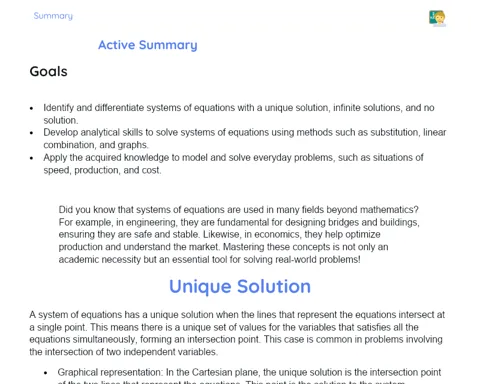Census and Sample Research | Active Summary
Objectives
1. 🎯 Clearly understand what census and sample surveys are, their fundamental differences, and when each is more appropriate.
2. 🎯 Develop skills to choose the most suitable type of survey for different situations, considering factors such as cost, time, and accuracy.
3. 🎯 Practice solving real problems involving the application of research methods, improving analytical and decision-making skills.
Contextualization
Did you know that major government and business decisions are often based on population surveys? For instance, the implementation of public policies, such as health or education programs, often depends on accurate data about the affected population. This data can be obtained through census or sample surveys, and choosing the right method can make all the difference in the effectiveness and economy of resources for these actions. Understanding and knowing how to apply these methods is crucial not only for mathematicians and statisticians but also for any citizen who wishes to understand the world around them and contribute to informed decisions in society.
Important Topics
Census Survey
The census survey is a data collection method that involves counting or measuring every element of the target population. This type of survey is extremely accurate, as there is no margin for sampling error, but it is also the most expensive and time-consuming, especially in large populations.
-
Accuracy: The main advantage of the census survey is its accuracy. By counting all elements of the population, it provides complete and exact data.
-
Cost and time: Due to its detailed nature, a census survey can be very costly and time-consuming, especially when compared to a sample survey.
-
Application: Ideal for situations where it is crucial to have exact data from the entire population, such as in censuses or in companies that want to know all their customers.
Sample Survey
The sample survey is a method that involves selecting a representative part of the population, known as a sample. This method is faster and more economical than the census, but the accuracy of the results depends on the representativeness of the chosen sample.
-
Efficiency: In terms of cost and time, the sample survey is advantageous, as it can provide reliable results with a smaller investment.
-
Representativeness: The key to the success of a sample survey is choosing a representative sample. This ensures that the results can be generalized to the larger population.
-
Application: Useful in market studies, opinion polls, and situations where an overview is needed, but a total count is impractical.
Comparison between Surveys
The choice between a census survey and a sample survey depends on several factors, including the objective of the survey, the size of the population, and the available resources. Understanding the differences between these methods is fundamental to deciding which is most suitable in different contexts.
-
Cost and Time: The census survey is more expensive and time-consuming, while the sample survey is more economical and faster.
-
Accuracy: The census survey provides precise results, but the sample survey, if well conducted, can be equally reliable.
-
Practical Application: The choice of method directly affects the application of results and the decisions based on them, making it crucial to understand the implications of each choice.
Key Terms
-
Census Survey: A method that involves counting or measuring each element of the population.
-
Sample Survey: A method that involves selecting a representative part of the population for analysis.
-
Target Population: The group of interest that is the subject of study in a survey.
-
Representative Sample: A part of the population that reflects the characteristics of the total population.
-
Margin of Error: The expected variation of survey results due to using a sample instead of a complete census.
To Reflect
-
Why is it important to consider the accuracy of data in a survey? How can the choice between a census and a sample survey affect this accuracy?
-
Discuss real situations where a census survey would be the only viable option. Why do these situations require a total count?
-
Think of a research project you could conduct. Which method (census or sample) would you choose and why? Consider factors like time, cost, and accuracy.
Important Conclusions
-
We reviewed how census and sample surveys work, highlighting their differences and applications. We learned that the choice of research method can directly affect the accuracy of results and the resources required.
-
We discussed practical examples that show the importance of these methods in real contexts, such as in government and business management, and how they influence data-driven decisions.
-
We emphasized the need to think critically when choosing between census and sample surveys, considering factors like time, cost, and accuracy, and how this can impact the effectiveness of decisions made based on these surveys.
To Exercise Knowledge
Create a survey on a topic of your interest, such as movie preferences among your friends. Choose between a census and a sample, and conduct your survey. Analyze the results and reflect on the choice of method.
Challenge
Data Detective Challenge: Imagine you are a data analyst at a large technology company. You need to determine how many people prefer Android or iOS in your country. Develop an effective research plan that is both fast and accurate. Present your strategy and the expected results in a report.
Study Tips
-
Use online survey apps to practice creating questionnaires and analyzing data. Try different types of questions and observe how they affect the results.
-
Watch educational videos that explain in detail how censuses and sample surveys are conducted in different countries. This can help visualize the process.
-
Join online forums or study groups about statistics and market research. Discussing with other students can provide new perspectives and useful tips.



